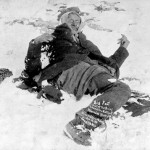The Sioux Story
If you’re from Hawaii and familiar with our Native Hawaiian “tribal” or “kingdom” issue, it’s fascinating to visit South Dakota and get immersed in its Native American (Lakota Sioux) issue.
Both natives make impossible-to-resolve land demands.
Both say part of their cultural breakdown has been caused by losing their land.
- Poverty is the earmark of Pine Ridge Sioux reservation BOB JONES PHOTO
- The Sioux did not get any of the choice lands in South Dakota BOB JONES PHOTO
- The frozen body of Sioux chief Big Foot, shot by U.S. soldiers at the Wounded Knee massacre Dec. 9, 1890 NATIONAL ARCHIVES PHOTO
In both cases, despite what the scholars say, it is not remotely possible that government will hand back the land this late in history.
To cancel land titles would create economic chaos.
But here’s the big difference.
In Hawaii, we’ve made a money settlement with Office of Hawaiian Affairs over ceded lands.
In South Dakota, the Sioux have refused to accept the money awarded them after a 56-year-long lawsuit. They want the Black Hills, the state’s touristic heart, more than 1 million acres.
So the award money sits in an interest-drawing escrow account and today is more than $500 million.
An 1851 treaty gave the Sioux sovereignty over the Black Hills, and the U.S. agreed to pay $50,000 a year for 50 years for the right of trail passage and train tracks. A year later, Washington fudged on the money and said $50,000 for 10 years.
In 1874, gold was discovered in the hills. Miners came. The Army claimed it was powerless to keep them all out. So the U.S. offered to buy the land for $5 million. The Sioux said no. Uncle Sam authorized the roundup of what it termed “hostile Indians” and re-settlement on bleak reservation land with meager food and medical supplies.
You probably know the rest.
The killing of George Custer and all his cavalry troops; the Wounded Knee massacre. The finality came in 1877 when Congress ordered the Sioux to relinquish the Black Hills and 23 million acres of surrounding land.
The “sovereignty” was no more.
In 1923, the Sioux filed a lawsuit in federal court. It was unceremoniously dismissed.
But by 1979 Americans were feeling guilty about our Indian history, and the court reconsidered. Even the U.S. Supreme Court agreed there was wrongful taking and upheld a $105 million award. That’s the $500 million today because of 5 percent accumulating interest.
Now the Sioux are squabbling, not unlike Native Hawaiians. Some want the money. Others say no, we must have the land.
Like some Hawaiians on DHHL lands, Sioux sit on land without much infrastructure: Pine Ridge Reservation — one of America’s poorest communities.
It’s “dry,” but you drive just across the Nebraska border into Whiteclay, population 10, with four bars and selling 4 million cans of beer a year. Guess where it’s going?
That’s what’s happened to the Lakota Sioux.
banyantreehouse@gmail.com






